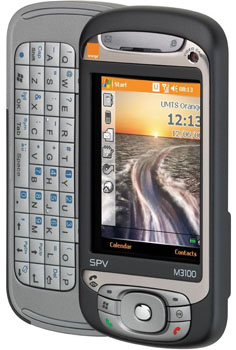This article is more than 1 year old
Orange SPV M3100 3G handset
The ultimate smart phone?
Moving on to the left-hand side of the device is a new addition: a scroll wheel. This allows you to navigate the M3100 more easily without having to take the stylus out, especially if you're reading emails or web pages. The scroll wheel can be depressed to make selections. Just below the scroll wheel is a second OK button, but this one also allows you to open the Start menu if you're on the Today screen. Below that is the voice dial/voice recorder button and, at the lower left-hand side, is a MicroSD memory card slot.

The power button, the Communications Manager button and, all the way on the bottom, the camera button are all on the right-hand side of the device. The stylus has been hidden right in the bottom corner. It's of the telescopic type and feels comfortable to hold. Finally, at the bottom of the M3100 you'll find the infra-red receiver, the reset button, a custom mini USB port and a small latch that opens the back.
The USB port has slightly different shape than usual, but you can still connect a standard mini USB plug - a battery charger with a mini USB connector is supplied. The reason for the customisation is to integrate the earphone adaptor - the M3100 doesn't have a headphone jack - so the connector doubles up as the port for the supplied headset, which is of rather better quality than those that shipped with previous SPVs.
Around the back is a two megapixel camera with a macro mode setting, an LED flash and a tiny self-portrait mirror. Release the catch that holds the back in place and you get access to the battery compartment. The SIM card slots in easily underneath the battery.
Internally, the SPV M3100 sports a Samsung 2442A processor which is clocked at 400MHz. This doesn't seem to be too fast, and if you intend to run Skype on the M3100 you're better off using the version developed for slower CPUs. The M3100 has 64MB of RAM and 128MB of Flash memory of which around 55MB is available to the user. On top of this you get 802.11b/g Wi-Fi and Bluetooth 2.0 with wireless stereo support, aka A2DP.
The M3100 operates on all four GSM frequencies (850/900/1,850/1,900MHz) as well as UMTS 850/1900 and 2100 networks. Rather unusually there's also support for UMTS 800MHz which seems to be used only in Japan. You should be able to use the M3100 anywhere in the world, roaming charges permitting.
